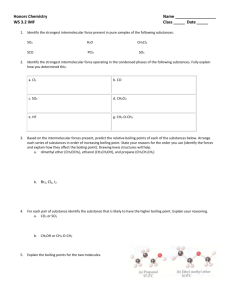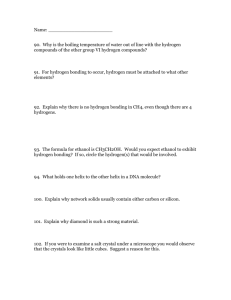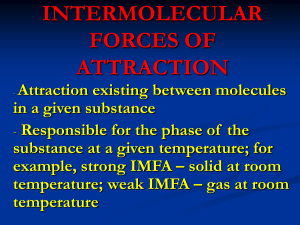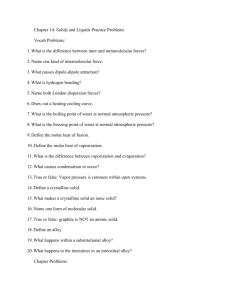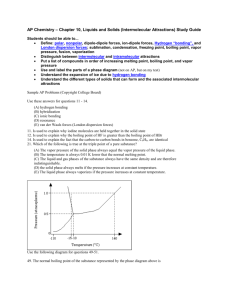Intermolecular forces explain why
advertisement
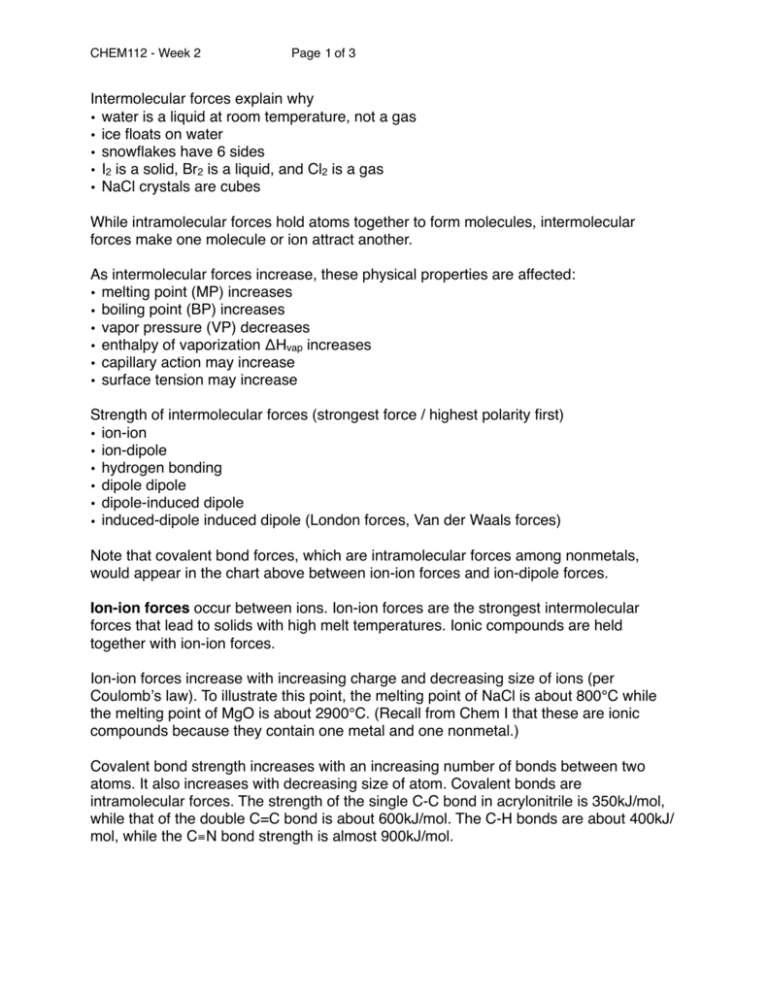
CHEM112 - Week 2 Page 1 of 3# Intermolecular forces explain why • water is a liquid at room temperature, not a gas • ice floats on water • snowflakes have 6 sides • I2 is a solid, Br2 is a liquid, and Cl2 is a gas • NaCl crystals are cubes While intramolecular forces hold atoms together to form molecules, intermolecular forces make one molecule or ion attract another. As intermolecular forces increase, these physical properties are affected: • melting point (MP) increases • boiling point (BP) increases • vapor pressure (VP) decreases • enthalpy of vaporization ΔHvap increases • capillary action may increase • surface tension may increase Strength of intermolecular forces (strongest force / highest polarity first) • ion-ion • ion-dipole • hydrogen bonding • dipole dipole • dipole-induced dipole • induced-dipole induced dipole (London forces, Van der Waals forces) Note that covalent bond forces, which are intramolecular forces among nonmetals, would appear in the chart above between ion-ion forces and ion-dipole forces. Ion-ion forces occur between ions. Ion-ion forces are the strongest intermolecular forces that lead to solids with high melt temperatures. Ionic compounds are held together with ion-ion forces. Ion-ion forces increase with increasing charge and decreasing size of ions (per Coulombʼs law). To illustrate this point, the melting point of NaCl is about 800°C while the melting point of MgO is about 2900°C. (Recall from Chem I that these are ionic compounds because they contain one metal and one nonmetal.) Covalent bond strength increases with an increasing number of bonds between two atoms. It also increases with decreasing size of atom. Covalent bonds are intramolecular forces. The strength of the single C-C bond in acrylonitrile is 350kJ/mol, while that of the double C=C bond is about 600kJ/mol. The C-H bonds are about 400kJ/ mol, while the C≡N bond strength is almost 900kJ/mol. CHEM112 - Week 2 Page 2 of 3# Intermolecular forces in acrylonitrile are indicated by the melting point of -84°C and the boiling point of 77°C. The melting point of acrylonitrile results from dipole-dipole forces, which are substantially weaker than for ion-ion forces. Dipole-dipole forces occur between polar molecules and increase between molecules having larger permanent dipoles (more electronegativity difference between atoms and less symmetry). An electronegativity difference causes a molecule to have an excess of negative charge around the more electronegative end and an excess of positive charge around the less electronegative end. Unless you mastered the skill in Chem I, draw the Lewis structure of a molecule and apply VSEPR theory to see if the molecule is symmetrical. To see the effect of the dipole-dipole forces between molecules, compare a physical property, such as boiling point. The boiling points of N2 and CO are -196°C and -192°C. CO has the higher boiling point because it is polar, while N2 is not. Both molecules have a molar mass of 28. Br2 (molar mass 160) has a boiling point of 59°C and ICl (molar mass 162) has a boiling point of 97°C. ICl has a higher boiling point because it is polar and experiences dipole-dipole forces. Ion-dipole forces occur between an ionic compound and a polar compound (such as water). Any trend that caused ion-ion forces to increase or dipole-dipole forces to increase causes ion-dipole forces to increase: • increase with increasing ion charge • decrease with increasing ion-dipole distance • increase with increasing dipole Small, highly charged cations have more exothermic solvation energies in water, so they have larger ion dipole forces. For example, Mg2+ has a solvation energy of about -1900kJ/mol, while Na+ has a solvation energy of about -400kJ/mol and Cs+ is about -260kJ/mol. As the radius of the ion decreases and the charge of the ion increases, the dissolution of the ion in water gives off more heat which shows the increasing strength of ion-dipole force. Many salts dissolve in water. CHEM112 - Week 2 Page 3 of 3# Hydrogen bonding is a special case of the dipole-dipole force that occurs when one of the nine patterns below occurs between two molecules (the pattern involves nitrogen, oxygen, or fluorine bonded to hydrogen and another polar nitrogen, oxygen or fluorine atom with a lone pair): δ+ ⋄⋄⋄δ−# # δ+ ⋄⋄⋄δ−# # δ+ ⋄⋄⋄δ− N-H ⋄⋄⋄ :N−# # O-H ⋄⋄⋄ :N−# # F-H ⋄⋄⋄ :N N-H ⋄⋄⋄ :O−# # O-H ⋄⋄⋄ :O−# # F-H ⋄⋄⋄ :O# N-H ⋄⋄⋄ :F−# # O-H ⋄⋄⋄ :F−# # F-H ⋄⋄⋄ :F# Hydrogen bonding between NH3 and H2O leads to NH4OH, ammonium hydroxide. Hydrogen bonding in water is particularly strong because water contains 2 hydrogens bound to oxygen, as well as two lone pairs on oxygen. This forms 2 hydrogen bonds per molecule. Ice has an open, lattice like structure because of hydrogen bonding. The open structure of ice causes it to be less dense than water, so ice floats on water. Hydrogen bonding makes ice one of a few substances where the solid is less dense than the liquid. Hydrogen bonding and the decrease in density when it freezes causes water to crack roads, mountains, and capped bottles. The strength of hydrogen bonding causes water to have an abnormally high specific heat capacity (Cp=4.184J/gK). The high specific heat capacity enables water to put out fires by cooling them down. Hydrogen bonding leads to the abnormally high boiling point of water. A small molecule like water would be expected to have a boiling point near -80°C. Hydrogen bonding makes the boiling point 100°C. The tertiary structure of proteins is held together by hydrogen bonds. DNA is held together by hydrogen bonds (adenine with thymine, guanine with cytosine).

